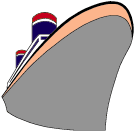

Goals:
Resources:
For Example:
Garzke, William H. & Dulin, Robert O. [1980]. Battleships. Annapolis: Naval Institute Press.
Jane, Fred T. (editor) [1969]. Jane's Fighting Ships 1914. New York: Arco Publishing Company, Inc.
Macaulay, David. [1993]. Ship. Boston: Houghton Mifflin Company.
Martinez-Hidalgo, Jose Maria. [1966]. Columbus' Ships. Barre, MA: Barre Publishers.
Zeitlin, Richard. [1988]. The U.S.S. Wisconsin: A History
of Two Battleships. Madison: State Historical Society of
Wisconsin.
Possible Sites:
Time required for lesson:
Procedure:
Assessment:
Subjects and Major Concepts Covered:
- Research skills
- Report construction
- Written reflection of concepts learned
- Interpersonal communication (small group work, presentations)
- Different types of ships - their characteristics, histories,
uses
- Constructing a drawing to scale
Possible Extensions:
Back to Curriculum Outline
WaveCrest - developed be Tina Huss, Alenne Grabowski, Mike Pable, & Francis M. Redmon
This page submitted by St. Norbert College Ocean Voyagers Program